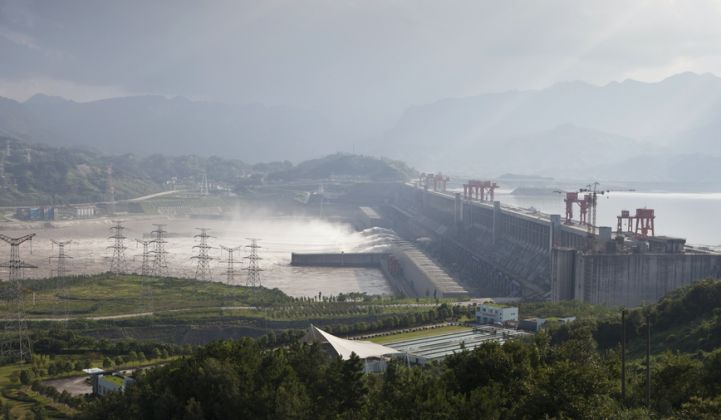In the past two years, China has added 53.2 gigawatts of wind energy capacity, with plans for another 31 GW in 2016. These are world-leading achievements, but their significance can be difficult to convey. A more concrete reference is needed.
Where does this activity stack up against, say, the largest power plant in the world?
In 2012, the last of the turbines in the Three Gorges Dam began generating electricity at rated power. Construction of the 22.5-gigawatt dam -- again, the biggest power station anywhere the world -- took 18 years. It exacted a large social and environmental toll: more than 1 million people were displaced and ecosystems were destroyed.
Now consider that by the end of 2016, China will have installed one Three Gorges Dam worth of low-cost, low-impact wind energy every year for the past three years.
That’s a compelling comparison. And it further shows how China’s dominance in renewables mirrors its dominance in industrial materials. (Last year, China accounted for 52 percent of the world's 62.7 gigawatts of wind energy installations. This is similar to the country’s share of worldwide coal, concrete and copper consumption, among others.)
Nameplate capacity versus annual production
Of course, nameplate capacity doesn’t equate to annual energy production, both for variable or baseload sources. The U.S. Energy Information Administration estimates that utility-scale solar photovoltaic installations in America had an average capacity factor of 29 percent in 2015, with utility-scale wind farms at 33 percent, coal plants averaging 55 percent, combined-cycle natural gas plants at 56 percent and nuclear plants at 92 percent.
Though the Three Gorges Dam has 1.5 times the rated capacity of the Itaipu Dam on the Brazilian-Paraguayan border, its lower utilization means the Itaipu Dam sometimes produces more power in a given year. (The Three Gorges Dam is rated to produce 85 terawatt-hours per year -- representing a capacity factor of 43 percent -- though it can exceed this figure with favorable rainfall or drawdowns in the reservoir water level.)
As for wind capacity factors, the Chinese turbine fleet has an average capacity factor of roughly 23 percent, so was slightly out-produced by America in 2015, despite the latter country’s smaller installation base.
This also means that China’s 32.5 gigawatts of wind energy installations would only be expected to produce half as much electricity as the 22.5-gigawatt Three Gorges Dam -- at least until capacity factors can be raised. (Low wind farm utilization in the country has been blamed in part on inadequate transmission capacity.)
Even so, China’s wind installations are climbing steadily upward -- surpassing the Three Gorges Dam in capacity each year. It won’t be very long before actual wind generation surpasses the Three Gorges Dam.
American wind in ‘Hoover units’
Completed in 1936, the Hoover Dam’s 2.08 gigawatts of generation capacity produces about 4.2 terawatt-hours of electricity per year. Though modest compared to newer hydro facilities, this was enough to make the Hoover Dam the world’s largest-producing hydroelectric power plant in the world by annual energy production for about a decade.
Using EIA’s 33 percent fleet-averaged capacity factor for American wind farms (probably an underestimate, as technology improvements have steadily increased the capacity factors of new wind farms), the roughly 8.5 gigawatts of new wind energy deployed in the United States in 2015 will produce almost 25 terawatt-hours of electricity on an annual basis. That’s almost six Hoover Dams’ worth of new carbon-free electricity production, or about one new “Hoover unit” every two months.
It’s possible that the multi-year extension of the federal Production Tax Credit will facilitate the deployment of a “Hoover unit” of wind energy in America every month. And with technological innovations and experience-curve effects improving performance across not just wind -- but solar and storage as well -- we’ll soon need new analogies to describe the growth of renewables.
***
Matthew Klippenstein (@EclecticLip) is a professional engineer and co-host of the EV-centric CleanTech Talk podcast. He has chronicled the Canadian electric-vehicle market for Green Car Reports since 2013. In his role with a leading renewable energy consultancy, he evaluates the wind energy potential of prospective wind farms.



